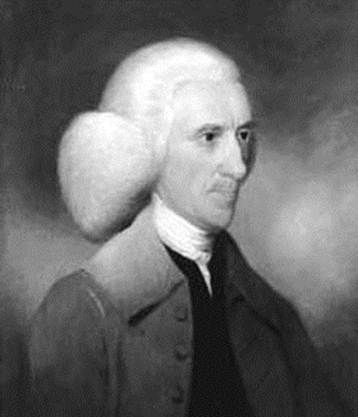


 تاريخ الرياضيات
تاريخ الرياضيات
 الرياضيات في الحضارات المختلفة
الرياضيات في الحضارات المختلفة 
 الرياضيات المتقطعة
الرياضيات المتقطعة
 الجبر
الجبر
 الهندسة
الهندسة 
 المعادلات التفاضلية و التكاملية
المعادلات التفاضلية و التكاملية 
 التحليل
التحليل
 علماء الرياضيات
علماء الرياضيات |
Read More
Date: 21-3-2016
Date: 21-3-2016
Date: 21-3-2016
|
Born: 1714 in St Andrews, Scotland
Died: 18 October 1786 in Edinburgh, Scotland

Alexander Wilson's parents were Clara Fairfoul and Patrick Wilson. When Alexander was born, his father Patrick was town clerk of St Andrews but, sadly, Patrick Wilson died when his son was a young child and he was brought up by his mother. Alexander was educated at the University of St Andrews and the university records show that he graduated with an MA on 8 May 1733. After this he was an apprentice to a surgeon in St Andrews, then he moved to London to continue his apprenticeship. In 1739 he returned to St Andrews and, in the following year, he married Jean Sharp, the daughter of a St Andrews merchant.
In 1742, Wilson, in partnership with a friend named Bain, set up a type foundry in St Andrews. Two years later Wilson and Bain moved their type foundry to larger premises in Camlachie close to Glasgow but in 1747 Bain moved to Dublin. Soon after this Bain quit the partnership leaving Wilson the sole owner of the type foundry. Jean and Alexander Wilson had three sons who eventually joined their father in the business. Jean, however, died and Wilson remarried in 1752.
The quality of the type produced by the foundry was outstanding and the finest of all was a Greek type. The Foulis Press in Glasgow, run by the two brothers Robert and Andrew Foulis, used Wilson's type and produced some of the finest and most beautiful books which no other press could match. Despite his other scholarly activities which we will examine below, the firm run by Wilson in partnership with his three sons continued to operate throughout his life. He published A Specimen of some of the Printing Types Cast in the Foundry of Alexander Wilson and Sons in 1772 which provides a fine example of the capabilities of the firm. In fact Alexander Wilson and Sons continued to be a thriving business after the death of its founder and the headquarters moved from Glasgow to London in 1834.
What were Wilson's 'other scholarly activities' we referred to above? He was an excellent physicist with special interests in astronomy and, in 1760, he was appointed to the chair of astronomy in Glasgow University, holding the post until he resigned in 1784. This did not mean that he took charge of a university department with teaching duties. Rather he was in charge of the Dowanhill observatory, newly built by Glasgow University, which operated as a research establishment. Wilson made many observations of sunspots discovering the Wilson effect in 1769. Using a geometric argument, he showed that sunspots were depressions in the Sun, publishing his results in papers of 1774 and 1783 in the Philosophical Transactions of the Royal Society of London. A similar theory had been proposed by La Hire and by Cassini but Lalande argued that sunspots were the tops of mountains showing above a liquid surface. The model of the Sun proposed by Wilson was of a dark body surrounded by a shell of highly luminous material. This model was accepted as true for 100 years and Wilson's theory that sunspots were depressions was 'proved' on 1861 when the first stereoscopic photographs of the sun were taken. Only after 1900 was Wilson's claim shown to be inaccurate, and one is certainly not looking at a dark body through a luminous shell with holes. The reason for the appearance of depressions was that strong magnetic fields, discovered by Hale in 1908, inhibit convection of hot gas which is increasing the temperature of the surrounding areas.
Wilson also published Thoughts on General Gravitation, and views thence arising as to the state of the universe (1770), in which he attempted to answer Newton's question:-
What hinders the fixed stars from falling upon one another.
Wilson's answer, that the entire universe rotates about a centre, is of course incorrect. It was, however, a quite logical attempt to answer this most perplexing question. Einstein attempted to answer the same question by introducing the 'cosmological constant' into the theory of general relativity. This he later believed was his greatest mistake when Hubble discovered the expansion of the universe. The question, of course, is still of major importance since recent results show that the expansion of the universe is speeding up.
We noted above that Wilson resigned his chair of astronomy at Glasgow in 1784. Not only did the type business pass to his sons, but so also did the chair of astronomy which was filled by Patrick Wilson, Alexander Wilson's middle son.
Wilson was awarded an honorary degree by the University of St Andrews on 6 August 1763 and was a founding member of the Royal Society of Edinburgh in 1783. He was awarded the gold medal of the Royal Danish Academy of Copenhagen in 1771 for his discovery of the Wilson effect.
Books:
Articles:



|
|
|
|
للعاملين في الليل.. حيلة صحية تجنبكم خطر هذا النوع من العمل
|
|
|
|
|
|
|
"ناسا" تحتفي برائد الفضاء السوفياتي يوري غاغارين
|
|
|
|
|
|
|
نحو شراكة وطنية متكاملة.. الأمين العام للعتبة الحسينية يبحث مع وكيل وزارة الخارجية آفاق التعاون المؤسسي
|
|
|